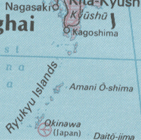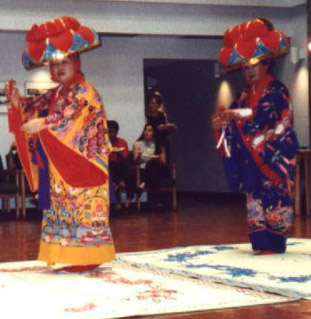Okinawans
 The people of
Okinawa, formerly the citizens of an independent Ryukyuan kingdom are another
minority culture in Japan, but in this case one that is quite intact. Originally
they were subject to persecution by their Japanese conquerors up until the end
of World War II, but are now considered as Japanese nationals. During World
War II the Okinawan language was banned and Okinawans were conscripted and suffered
horribly in the Japanese military.
The people of
Okinawa, formerly the citizens of an independent Ryukyuan kingdom are another
minority culture in Japan, but in this case one that is quite intact. Originally
they were subject to persecution by their Japanese conquerors up until the end
of World War II, but are now considered as Japanese nationals. During World
War II the Okinawan language was banned and Okinawans were conscripted and suffered
horribly in the Japanese military.
 There was a
USA military occupation of Okinawa after World War II which lasted until 1972
when Okinawa was returned to Japan on condition that it function as a base to
support the Japan-USA Security Treaty. However, the people of Okinawa have resented
USA military bases on their islands ever since. Listen to the facts here from
Okinawa radio.
There was a
USA military occupation of Okinawa after World War II which lasted until 1972
when Okinawa was returned to Japan on condition that it function as a base to
support the Japan-USA Security Treaty. However, the people of Okinawa have resented
USA military bases on their islands ever since. Listen to the facts here from
Okinawa radio.
 Okinawa was
based on a unique ethnic culture different from that of Japan. Though subject
to Japanese Shinto influences after the Meiji Restoration (1868), an individual
tradition has been well preserved. Today one can still see the form of various
folk traditions, particularly music and dance which play an important part in
the cultural identity of Okinawa.
Okinawa was
based on a unique ethnic culture different from that of Japan. Though subject
to Japanese Shinto influences after the Meiji Restoration (1868), an individual
tradition has been well preserved. Today one can still see the form of various
folk traditions, particularly music and dance which play an important part in
the cultural identity of Okinawa.
Okinawa has a strong musical culture with distinct instruments that distinguishes
it from mainstream Japanese musical culture. The basic musical scale is, in
itself, different from Japanese folksongs and rarely found in music of other
regions. When used, the scale demonstrates the characteristic melodies of Okinawa
that are uniquely recognisable. The sanshin is the main musical instrument.
It is a 3 stringed lute which is plucked. It is not found on mainland Japan,
but did migrate there to become established as the shamisen. Okinawa
folk songs are still being composed and this forms a strong contrast with other
districts of Japan, where only folk songs from the past are sung. The Okinawa
folk songs are also adapted by Ryukyu rock groups which gained popularity both
in Japan and overseas.
|
MUSIC FROM
OKINAWA
|
|
Information
about & sounds inspired from Okinawa, Japan
|
|
Musical Scale
|
Music
|
Artist
|
|
3
silk or tetron strings of the sanshin (low to high):
wu jiro (male);
naka jiro (centre);
mi jiro (female).
|
|
This piece is called Okinawan
Trial and is by Kaznao Mimaki. Kaz has created a wealth of
world music on his PC. Okinawan Trial uses a pentatonic scale,
ie lacking the notes Re & La. Visit Kaz's website at:
Kaz
Mimaki's Music World
|
|
Ascending
ryukyu scale:
C, E, F, G, B, c
|
|
|
Descending
melodic ryukyu (with ritsu tetrachord) scale:
c, B, G, F, D, C
|
This is the sanshin - a plucked
lute. It consists of a long, black-lacquered ebony neck which pierces
the top and bottom of an open frame-shaped body covered on both sides
with snakeskin. The strings are plucked with a plectrum made of water-buffalo
horn using the index finger of the right hand..
|
|
Common sanshin tuning:
1 5 1 or B F# b
|
|
 The people of
Okinawa, formerly the citizens of an independent Ryukyuan kingdom are another
minority culture in Japan, but in this case one that is quite intact. Originally
they were subject to persecution by their Japanese conquerors up until the end
of World War II, but are now considered as Japanese nationals. During World
War II the Okinawan language was banned and Okinawans were conscripted and suffered
horribly in the Japanese military.
The people of
Okinawa, formerly the citizens of an independent Ryukyuan kingdom are another
minority culture in Japan, but in this case one that is quite intact. Originally
they were subject to persecution by their Japanese conquerors up until the end
of World War II, but are now considered as Japanese nationals. During World
War II the Okinawan language was banned and Okinawans were conscripted and suffered
horribly in the Japanese military.  There was a
USA military occupation of Okinawa after World War II which lasted until 1972
when Okinawa was returned to Japan on condition that it function as a base to
support the Japan-USA Security Treaty. However, the people of Okinawa have resented
USA military bases on their islands ever since. Listen to the facts here from
There was a
USA military occupation of Okinawa after World War II which lasted until 1972
when Okinawa was returned to Japan on condition that it function as a base to
support the Japan-USA Security Treaty. However, the people of Okinawa have resented
USA military bases on their islands ever since. Listen to the facts here from
 Okinawa was
based on a unique ethnic culture different from that of Japan. Though subject
to Japanese Shinto influences after the Meiji Restoration (1868), an individual
tradition has been well preserved. Today one can still see the form of various
folk traditions, particularly music and dance which play an important part in
the cultural identity of Okinawa.
Okinawa was
based on a unique ethnic culture different from that of Japan. Though subject
to Japanese Shinto influences after the Meiji Restoration (1868), an individual
tradition has been well preserved. Today one can still see the form of various
folk traditions, particularly music and dance which play an important part in
the cultural identity of Okinawa. 